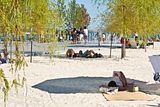dt_toronto_geek
Superstar
The one thing that really surprised me was how diverse the group of people were ranging from families with young babies, to older couples, to younger people just suntanning and and relaxing with friends. All in all it is an amazing space and a great asset to the city
I even saw a two gay couples making no bones about holding back from enjoying each other's company, one handsome duo is pictured below in the centre
